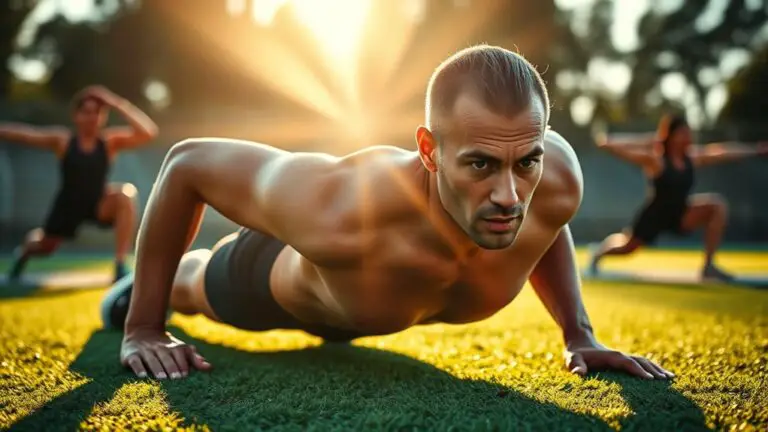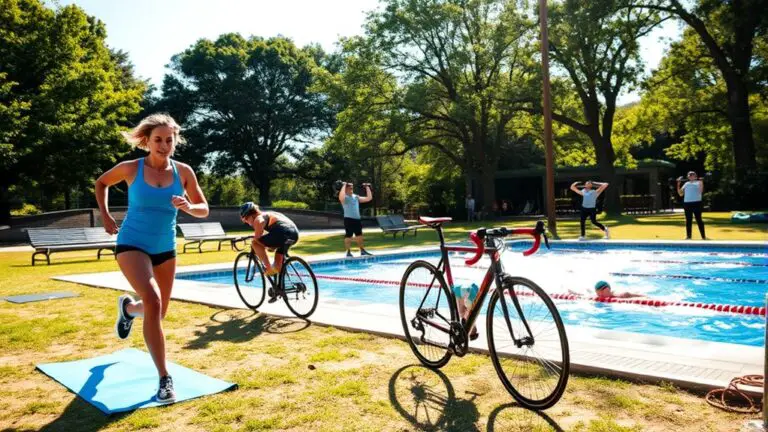The Best Gym Workouts for Endurance Cycling

To excel in endurance cycling, incorporate strength training, high-intensity interval training (HIIT), and core stability exercises into your routine. Focus on major muscle groups with squats and deadlifts to build power. Mix in plyometric workouts and endurance circuits to improve stamina. Don’t forget about flexibility and recovery techniques like foam rolling to enhance performance and prevent injuries. By mastering these elements, you’ll greatly boost your cycling capabilities. There’s even more to discover to elevate your game further!
Strength Training for Cyclists

When it comes to boosting your cycling performance, strength training is a game-changer. By incorporating resistance training into your routine, you can enhance your power and endurance on the bike. Focus on exercises that target your major muscle groups, like squats and deadlifts, which mimic the movements you’ll encounter while cycling.
Utilizing powerlifting techniques, you’ll not only build strength but also improve your muscle efficiency. This translates to better pedal strokes and less fatigue during long rides. Don’t shy away from heavier weights; they’ll help you develop the explosive strength needed for those challenging climbs and sprints. Incorporating isolation exercises for biceps can further enhance your overall upper body strength, which is crucial for maintaining proper cycling posture.
Aim for two to three strength sessions a week, balancing between upper and lower body workouts. Remember, the goal is to complement your cycling, not replace it. By embracing strength training, you’ll become a more powerful and resilient cyclist, ready to tackle any challenge on the road.
High-Intensity Interval Training (HIIT)
If you want to elevate your cycling performance, incorporating High-Intensity Interval Training (HIIT) into your workouts can be a game-changer. HIIT benefits include improved cardiovascular fitness, increased power output, and enhanced endurance—key elements for any cyclist. You can perform HIIT on a stationary bike, alternating between short bursts of maximum effort and recovery periods.
For example, sprint at full effort for 30 seconds, then pedal at a low intensity for 1-2 minutes to recover. Repeat this cycle for 15-20 minutes. Another effective HIIT example is the Tabata method: 20 seconds of all-out effort followed by 10 seconds of rest, repeated for four minutes.
These workouts not only maximize your time in the gym but also push your limits, helping you tackle those long rides with more stamina. Embrace HIIT, and watch your cycling performance soar!
Core Stability Exercises
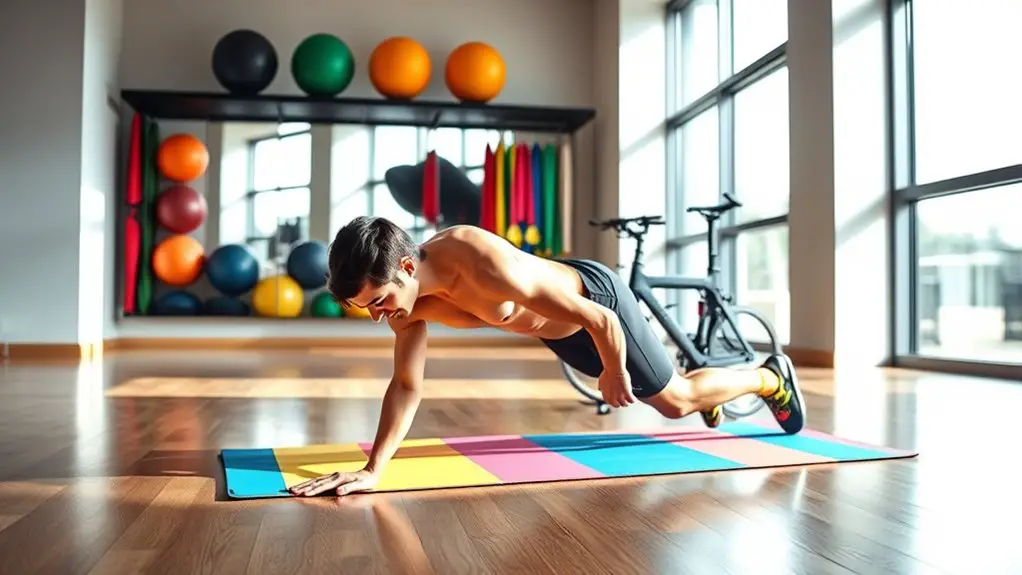
Building on the benefits of HIIT, incorporating core stability exercises into your routine can greatly enhance your cycling performance. Strong core engagement is essential for maintaining proper posture and power transfer while you ride. Exercises like planks, bridges, and Russian twists help develop the muscles that support your spine, allowing for better stability on the bike.
Not only do these exercises improve your balance, but they also reduce the risk of injury. With increased stability benefits, you’ll notice improved endurance during long rides, as your body becomes more efficient in transferring energy. Additionally, incorporating jump rope workouts can provide a fun way to enhance your overall fitness and coordination.
Make core stability a priority in your workouts, and you’ll see the difference on the road. Consistent practice will lead to greater control and comfort while cycling, making each ride more enjoyable. So, immerse yourself in these exercises and feel the power of a strong core propel you forward!
Plyometric Workouts
Plyometric workouts can supercharge your cycling performance by enhancing your power and explosiveness. Incorporating exercises like box jumps and jump squats not only builds strength but also improves your overall endurance on the bike. Let’s explore how these dynamic movements can benefit your training regimen and keep you pedaling strong!
Benefits of Plyometrics
While many cyclists focus solely on endurance, incorporating plyometric workouts into your routine can yield significant benefits for performance and power. Plyometric benefits include enhanced explosive power, which translates to quicker acceleration and stronger sprinting capabilities on the bike. By engaging in exercises that involve rapid stretching and contracting of muscles, you’ll improve your overall muscle efficiency and coordination. This means you can transfer energy more effectively while cycling, leading to better endurance over longer rides. Plus, plyometrics can help reduce the risk of injury by strengthening tendons and ligaments. So, if you want to take your cycling to the next level, don’t underestimate the impact of these dynamic movements in your training regimen.
Sample Plyometric Exercises
Incorporating plyometric exercises into your training can greatly enhance your cycling performance, so let’s explore some effective movements to get you started. First up are box jumps. These explosive jumps not only build leg strength but also improve your power output on the bike. Start with a stable box, jump onto it, and step back down—aim for three sets of 10 reps. Next, try depth jumps. This exercise focuses on reactive strength and involves stepping off a box, landing softly, and jumping as high as you can upon impact. Perform three sets of 8 reps. By integrating these plyometric exercises into your routine, you’ll boost your endurance and overall cycling efficiency. Get ready to pedal harder and longer!
Flexibility and Mobility Routines
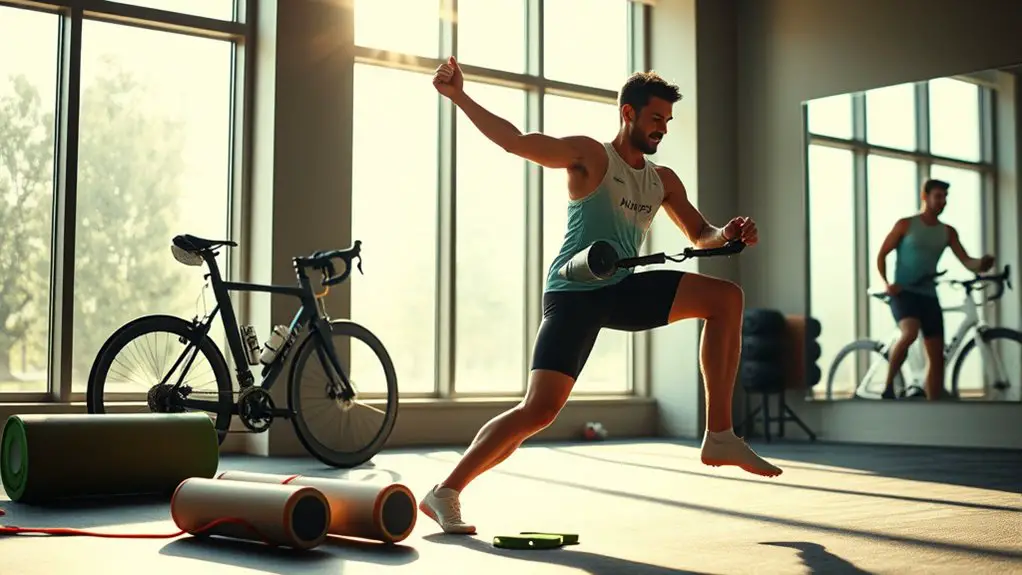
Incorporating flexibility and mobility routines into your training is essential for enhancing your endurance cycling performance. By focusing on dynamic stretching techniques and foam rolling, you can improve your range of motion and reduce the risk of injury. Let’s explore how these practices can elevate your cycling game and keep you riding strong.
Importance of Flexibility
Flexibility plays an essential role in enhancing your endurance cycling performance. Incorporating flexibility routines, such as yoga, can greatly improve your range of motion and reduce the risk of injury. By practicing effective stretching techniques, you not only enhance your cycling efficiency but also promote quicker recovery.
Here’s a quick reference table on flexibility benefits:
| Benefit | Description | Example |
|---|---|---|
| Injury Prevention | Reduces tightness in muscles | Hamstring stretches |
| Improved Performance | Enhances pedal efficiency | Hip openers |
| Better Recovery | Aids muscle repair | Child’s pose |
| Increased Range of Motion | Allows for smoother movements | Quadricep stretches |
| Stress Relief | Promotes relaxation | Deep breathing yoga |
Embrace these techniques and elevate your cycling journey!
Dynamic Stretching Techniques
While static stretching has its place, dynamic stretching techniques are essential for cyclists aiming to boost their flexibility and mobility. Incorporating dynamic warm ups into your routine not only prepares your body for the demands of cycling but also enhances your overall performance. Think leg swings, arm circles, and walking lunges; these movements increase blood flow and activate the muscles you’ll rely on during your rides.
Dynamic stretching is key for injury prevention, as it helps maintain joint health and improves your range of motion. By regularly integrating these techniques into your workouts, you’ll find yourself more agile and resilient on the bike. So, get moving! Your body will thank you when you tackle those long rides with ease and confidence.
Foam Rolling Benefits
Releasing the benefits of foam rolling can considerably enhance your cycling performance and recovery. By incorporating foam rolling techniques into your routine, you’re not just easing muscle tension; you’re also boosting flexibility and mobility. Here are four key benefits to evaluate:
- Improved Blood Flow: Foam rolling enhances circulation, delivering oxygen and nutrients to your muscles.
- Reduced Muscle Soreness: It helps alleviate post-ride soreness, allowing for quicker recovery.
- Increased Range of Motion: Regular foam rolling expands your flexibility, improving your pedaling efficiency.
- Injury Prevention: It aids in identifying and addressing tight spots, reducing the risk of injury.
Integrate a foam rolling routine into your training, and watch your cycling performance soar!
Endurance Circuit Training
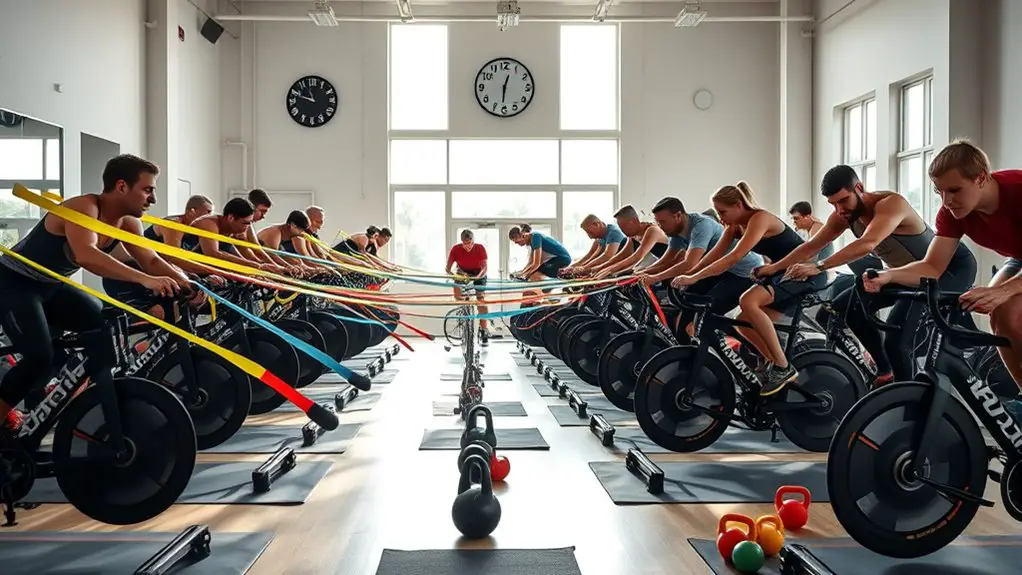
Endurance circuit training offers an efficient way to build stamina and strength simultaneously, making it a perfect complement to your cycling routine. By incorporating circuit techniques, you can enhance your endurance benefits while keeping workouts dynamic and engaging.
Start with a combination of bodyweight exercises like squats, lunges, and push-ups, and mix in some resistance training. Shift quickly between exercises to keep your heart rate elevated, which mimics the demands of cycling. Aim for circuits that last 30-60 seconds, followed by a short rest period. This structure not only boosts your muscular endurance but also improves your aerobic capacity.
Don’t shy away from adding plyometric moves like jump squats or burpees to challenge your body further. With consistent practice, you’ll notice improvements in your cycling performance, allowing you to tackle longer rides with confidence and energy. Embrace these circuits, and watch your endurance soar!
Recovery Workouts and Active Rest
To maximize your cycling performance, incorporating recovery workouts and active rest into your routine is essential. These practices help your body recover while keeping you engaged. Here are four effective active recovery techniques:
Incorporating recovery workouts and active rest is crucial for enhancing your cycling performance and keeping your body engaged.
- Gentle Cycling: Take a leisurely ride at a low intensity to promote blood flow and reduce muscle soreness.
- Yoga: Engage in restorative yoga sessions to enhance flexibility, balance, and mental focus.
- Foam Rolling: Use a foam roller to release tight muscles and improve circulation, speeding up recovery.
- Light Strength Training: Focus on low-weight, high-rep exercises that strengthen without straining your muscles.
Frequently Asked Questions
How Often Should I Incorporate Gym Workouts Into My Cycling Routine?
To maximize your cycling performance, you should aim for a balanced gym frequency that complements your ride schedule. Incorporating gym workouts two to three times a week is ideal. This way, you’re building strength without overtraining. Focus on exercises that enhance your core and legs, while allowing rest days for recovery. Finding this workout balance will help you build endurance, power, and prevent injuries, keeping you motivated and ready to ride!
What Should I Eat Before and After Gym Workouts for Cycling?
When it comes to pre workout nutrition, aim for a mix of carbs and protein about 30-60 minutes before your gym session. Think bananas with peanut butter or a smoothie. After your workout, focus on post workout recovery with a protein-rich meal or snack, like Greek yogurt or a protein shake, to help your muscles recover. Remember, fueling your body right can boost your performance and keep you energized for your rides!
Can Gym Workouts Improve My Cycling Performance Significantly?
Absolutely, gym workouts can greatly improve your cycling performance! By incorporating strength training into your routine, you’ll enhance your cycling efficiency. Stronger muscles can generate more power, allowing you to tackle hills and maintain speed with less effort. Plus, a solid strength base can help prevent injuries, keeping you on the bike longer. So, don’t underestimate the gym; it’s a powerful tool to elevate your cycling game and boost your overall endurance!
What Equipment Do I Need for Effective Gym Workouts?
To get the most from your gym workouts, you’ll need some essential equipment. Start with free weights for strength training, like dumbbells and kettlebells, to build muscle. Resistance bands are great for versatility. Don’t forget cardio equipment, such as treadmills or stationary bikes, to enhance your endurance. A stability ball can also improve your core strength. With the right gear, you’ll be well-equipped to elevate your fitness and achieve your goals!
How Do I Prevent Injuries During Gym Workouts for Cycling?
To prevent injuries during your gym workouts, focus on injury prevention through proper form. Always warm up before exercising and use weights that challenge you without compromising your technique. Pay attention to your body; if something doesn’t feel right, stop. Incorporating flexibility and strength training can also help. Remember, it’s not just about pushing harder, but training smarter. Stay consistent, listen to your body, and you’ll set yourself up for long-term success!
